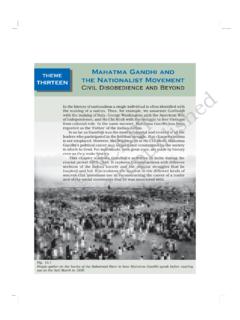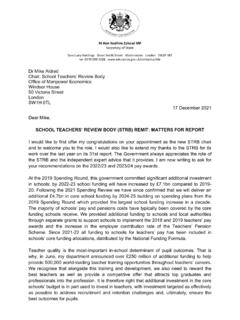Transcription of Best start in life and beyond - GOV.UK
1 Best start in life and beyond Improving public health outcomes for children, young people and families Guidance to support commissioning of the healthy child programme 0 to 19. Guide 1: Background information on commissioning and service model 1. Best start in life and beyond : Improving public health outcomes for children, young people and families Commissioning guide 1: Background information on commissioning and service model Contents Introduction .. 3. The Healthy Child Programme .. 4. Support for children in mainstream education with additional health needs .. 6. Purpose of the guidance .. 6. Commissioning responsibilities for child health and wellbeing .. 7. Commissioning public health services for children and young people 0 to 19 .. 7. Health visiting and school nursing services (public health nursing workforce).
2 8. Regulation and employer issues .. 13. 13. Associated tools and guidance .. 14. 2. Best start in life and beyond : Improving public health outcomes for children, young people and families Commissioning guide 1: Background information on commissioning and service model Introduction This is one of 3 supporting guides to assist local authorities in the commissioning of health visiting and school nursing services to lead and co-ordinate delivery of public health for children aged 0 to 19. Public Health England supports local authorities and the NHS in securing the greatest gains in health and wellbeing and reductions in health inequalities through evidence- based interventions. In October 2014, PHE published From Evidence into Action: Opportunities to protect and improve the nation's health.
3 This is closely linked to the NHS Long Term Plan, the Prevention Green Paper and the NHS Five Year Forward View. Ensuring every child has the best start in life is one of PHE's key priorities. Best start in Life has been identified as a priority within Public Health England's 5-year strategy, which runs from 2020 to 2025. A major contribution to achieving these ambitions and strategies is the modernisation of the Healthy Child Programme. The Healthy Child Programme is a universal programme available to all children and aims to ensure that every child gets the good start they need to lay the foundations of a healthy life. Universal and targeted public health services provided by health visiting and school nursing teams are crucial to improving the health and wellbeing of all children and young people.
4 The foundations for virtually every aspect of human development including physical, intellectual and emotional, are established in early childhood. Sustaining this across the life course for school-aged children and young people is important to improve outcomes and reduce inequalities through universal provision and personalised response. There may be challenges within a child's or a young person's life and times when they need additional support (No Child Left Behind, PHE 2020). Children in care, for example, experience more frequent moves of home and school so may face additional challenges (Stability Index, Children's Commissioner, 2019). Modernising the Healthy Child Programme is intended to enable effective, focused services where additional needs are identified along with use of the latest evidence on effective practice and helping to bring councils, the NHS and partners together to achieve priority outcomes for children and families.
5 Delivering this vision is reliant upon a wide range of partners working together and embracing change in order to: 3. Best start in life and beyond : Improving public health outcomes for children, young people and families Commissioning guide 1: Background information on commissioning and service model ensure high quality services for children, young people and families from actions to improve women's health before, during and after pregnancy (Maternity Transformation Programme). give every child the best start in life (childhood obesity, speech, language and communication, immunisations). support school readiness and improve resilience for school-aged children. support young people transitioning to adult services Key public health priorities are supported by national enabling actions in shaping local services to plan the design and delivering for the populations identified health example, the Social Mobility Action Plan for Education (Department for Education, 2017): Unlocking Talent, Fulfilling Potential' includes a plan for the early years with a focus on improving early language acquisition.
6 The importance of effective outcomes relies on strong collaborative partnerships with the child, family or carers and all partners in health (primary and secondary), local authority including early years services, and voluntary sector services. The Healthy Child Programme Good health, wellbeing and resilience are vital for all our children now and for the future of society. There is good evidence about what is important to achieve this through improving children and young people's public health. This is brought together in the national Healthy Child Programme 0 to 19, which includes: Healthy Child Programme: Pregnancy and the first five years of life (DH and DCSF, 2009). Healthy Child Programme rapid review to update evidence (PHE, 2015). Healthy Child Programme: From 5 to 19 years old (DH and DCSF, 2009).
7 PHE have published a rapid review of the evidence in relation to safeguarding guidance in the Healthy Child Programme for 5 to 19 year olds. The review focuses on the areas of child abuse and neglect, child sexual abuse and exploitation, intimate partner violence (IPV), female genital mutilation (FGM) and gang violence. In line with the remit of the Healthy Child Programme for 5 to 19 year olds, the focus is on prevention and early intervention. The 0 to 5 element of the Healthy Child Programme is led by health visiting services and the 5 to 19 element is led by school nursing services. Together they provide place-based services and work in partnership with education and other providers where needed. The universal reach of the Healthy Child Programme provides an invaluable opportunity from early in a child's life to identify families that may need additional support and children who are at risk of poor outcomes.
8 4. Best start in life and beyond : Improving public health outcomes for children, young people and families Commissioning guide 1: Background information on commissioning and service model The Healthy Child Programme provides a framework to support collaborative work and more integrated delivery. It aims to: help parents, carers or guardians develop and sustain a strong bond with children support parents, carers or guardians in keeping children healthy and safe and reaching their full potential protect children from serious disease, through screening and immunisation reduce childhood obesity by promoting healthy eating and physical activity promote oral health support resilience and positive maternal and family mental health support the development of healthy relationships and good sexual and reproductive health identify health and wellbeing issues early, so support and early interventions can be provided in a timely manner make sure children are prepared for and supported in all childcare.
9 Early years and education settings and are especially supported to be ready to learn at 2 and ready for school by 5. Being ready for school is assessed as every child reaching a level of development which enables them to: communicate their needs and have good vocabulary become independent in eating, getting dressed and going to the toilet take turns, sit still and listen and play socialise with peers, form friendships and separate from parent(s). have good physical health, including dental health be well nourished and within the healthy weight for height range have protection against vaccine-preventable infectious diseases, having received all childhood immunisations It also involves continued support through school age years to help every child to thrive and gain maximum benefit from education, driving high educational achievement identifying and helping children, young people and families with problems that might affect their chances later in life, including building resilience to cope with the pressures of life 5.
10 Best start in life and beyond : Improving public health outcomes for children, young people and families Commissioning guide 1: Background information on commissioning and service model Support for children in mainstream education with additional health needs Children with additional or complex health needs often require additional support to ensure a seamless transition into school, and to feel supported to learn within an education setting (Children with special educational needs and disabilities, SEND). Commissioning arrangements should be developed to clarify the contributions from partners in health, social care and education to ensure that children with additional or complex needs are school ready and supported within education settings. Commissioning guidance 2, appendix 2 provides an overview which local partners may wish to consider.














